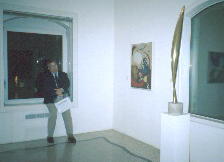Peggy Guggenheim's Museum
by Louis Bignami
Most museums fill wall space with second-rate works of first-rate artists or, if you are lucky, first-rate works by second-rate artists. Peggy Guggenheim's Museum only runs to a dozen or so rooms, but each is stuffed with the best of 20th century art collected by one of the most interesting women of the 20th century. What else can one expect from who lived in the last period ( 1920-1960) when great modern art was available at affordable, at least for a Guggenheim, prices?
While, in part because her father died heroically on the Titanic, Peggy didn't have the funds of many Guggenheims who, when World War I started, owned 70% of the lead, copper and silver in the world, she combined honed her unerring eye with great teachers who included husbands Laurence Vail, a Dada sculptor, and Surrealist painter Max Ernst. Only Peggy could have seen in the unfinished one-story Palazzo Venier dei Leoni, on the Grand Canal that became her home after WW II, the best small museum in the world.

Louis Bignami enjoying the museum
photo credit Annette Bignami
Her art and generous lifestyle reflected her unique nature. She had the confidence of the rich and beautiful: the wonderful Man Ray photo of her in the Museum's guide, shows an elegant, slender charmer in a gold lame' dress with a Stravinsky top who quite fit into the Paris of the 1920s with her first of three husbands, Laurence Vail. Later photos almost always showed her in high fashion with small pups.
But she was more than a rich dilettante. She worked at her art. For example, in 1939, as WW II loomed, she'd opened Guggenheim Jeune Gallery in London with Jean Cocteau, and followed up with the first British showing of Vasily Kandinsky, sculpture by Brancusi, paintings by Duchamp and works of Henry Moore and others.
She bought the best works of these artists like the wonderful "The Sun in its Jewel Case." By 1939 she noted, "I felt that if I was losing that money I might as well lose a lot more and do something worthwhile." So between 1939 and 1942 she bought the modern art the Nazi's so hated. It forms the basis of her collection and contributes so to other Guggenheim museums. Miro', Picasso, Braque, Margritte, Gris, Dali' and husband Max Ernst's paintings were but samples. It's worth nothing that Ernst's Surreal "Attirement of the Bride and The Antipope" demonstrate his impeccable hand and contrast nicely with his earlier works.
In New York for the duration of WW II, her museum gallery showed Mondrian, Calder, Klee, Duchamps, and other European artists. After 1943, she hosted Jackson Pollock's first one-man show. At one time she owned 18 of his paintings even after giving several to museums. The Pollock's here in the museum include both painted and poured masterworks that are some of the best in the world, and wall a gallery with an astonishing Calder! American abstract impressionists like Robert Motherwell, Mark Rothko and Willem de Kooning joined Pollack with Guggenheim support and Peggy became the mother hen of displaced European surrealist and abstract artists, and Americans who followed. All met in her gallery and town house and fell under her, and each other's influence.
Peggy's lifestyle probably defines "artistic impulse." After she moved to Venice in 1949 she scandalized locals by sunbathing on her roof, and wasn't above tossing a Giacometti plaster in the back of her car to tote to the bronze casters. She slept in a bed with a silver Calder headboard, hung her earring collection by major artists on the wall, buried her lap dogs in the yard, dined below a major Picasso, and if all the great art that she gave away or sold had remained in her hands, her museum would approach Academia size and be far too much to visit in a week.
Today, "Peggy's Place" , now run as part of the Solomon R Guggenheim Foundation with other wonderful museum in Bilbao, Spain and New York City, is best visited by gondola down the Grand Canal past the Salute and entered past the "erect" horseman's statue in the courtyard. Through a window on the right Brancusi's "Bird in Space" waits in front of a wonderful Miro'. Enjoy that, and then dabble with Dali' and other greats in the small galleries to the right. Then squint so you can't see clearly and head towards the back of the glass-walled room where Peggy dined. Open your eyes and feast on the Giacometti plaster inside, the small pieces by Moore and others, and the sculpture outside to be visited later. Turn, and Picasso's "Le Poète" shows why his best works still stun.
On the Salute side of the entrance hall it's time for Pollock and Calder and all the other artists Peggy Guggenheim knew, loved and supported. Consider the case of modern art in Europe under Hitler. Think for a bit how she kept a generation or even two of great artists going. Then it's past time to go out into the courtyard to visit her grave, where, surrounded by the graves of the small dogs that doubtless returned her affections more consistently than the "large artists," she rests.
